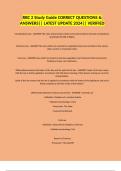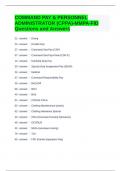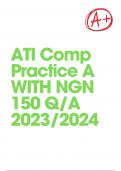RBC 2 Study Guide CORRECT QUESTIONS &
ANSWERS|| LATEST UPDATE 2024|| VERIFIED
Constitutional Law - ANSWER The rules and provisions which are found in federal and state constitutions,
specifically the Bill of Rights.
Statutory Law - ANSWER The laws which are enacted by a legislative body and recorded in the various
state, county, or municipal codes.
Case Law - ANSWER Laws which are based on previous appellate court decisions that have become
binding on lower court decisions.
Differentiate between the letter of the law and the spirit of the law - ANSWER "Letter of the law means
that the law is strictly applied in accordance with the literal meaning of the statute, leaving no room for
interpretation.
Spirit of the law means that the law is applied in accordance with the intent of the legislature and not in
literal compliance with the words of the statute."
Differentiate between criminal and civil law - ANSWER "Criminal Law
- Definition: Violation of a criminal statute
- Violation Terminology: Crime
- Prosecutor: The State
- Purpose Punishment
Civil Law
- Definition: Noncriminal violations of the law
- Violation terminology: Tort
Breach of Contract
- Prosecutor: The plaintiff
, - Purpose: Redress"
Recall the statutory definition of a crime - ANSWER Penal code 15 - an act committed or omitted in
violation of a law forbidding or commanding it, and to which is annexed, upon conviction, a penalty that
provides the following punishments for the crime: death, imprisonment, fine, removal from officer,
disqualification to hold and enjoy any officer of honor, trust or profit in the State of California.
Identify the basic elements common to all crimes - ANSWER Penal code 20 - in every crime or public
offense, there must exist a union, or joint operation of act and intent, or criminal negligence
Identify the basic elements required of an attempt to commit a crime - ANSWER An attempt to commit a
crime consists of intent to commit that crime and a direct, but ineffectual, act done toward its
commission
General intent - ANSWER Intent is presumed and does not have to be proven. Definition of a crime
consists only of the description of a particular act, without reference to intent
Specific intent - ANSWER An element of a crime that must be proven and cannot be presumed; the
requirement of the specific intent element varies according to the definition of the crime
Transferred intent - ANSWER When an unlawful act affects a person other than, or in addition to, the
person it was intended to affect
Criminal Intent - ANSWER A mental state or frame of mind that the person knowingly did the particular
criminal act (break the law).
Criminal Negligence - ANSWER A negligent act that is aggravated or reckless, and constitutes indifference
to the consequences
Felony - ANSWER A crime punishable by a fine and/or imprisonment in state prison, death or removal
from officer
Misdemeanor - ANSWER A crime punishable by a fine and/or imprisonment in a county jail
, Wobbler - ANSWER A crime that can be either a felony or a misdemeanor.
Principals to a crime - ANSWER "A principal to a crime is anyone who:
- directly committed the offense
- aided and abetted
- advised and encouraged
- counseled, advised, or encouraged children under the age of 14 years, or mentally incapacitated
persons
- by fraud, contrivance, or force, occasioned the drunkenness of another
- by threats, menaces, command, or coercion compelled another"
Accessories to a crime - ANSWER "An accessory is anyone who, after a felony has been committed,
meets all the following requirements: (Penal Code Section 32)
- has knowledge that the principal has committed, has been charged with, or has been convicted of
committing a felony
- harbors, conceals, or aids a principal in the felony
- has the intention of assisting the principal to avoid or escape arrest, trial, conviction, or punishment
The crime of accessory is punishable by imprisonment in the state prison or in a county jail and/or fine.
(Penal Code Section 33)"
Accomplices to a crime - ANSWER "A principal to a crime becomes an accomplice when he or she
testifies for the prosecution against another principal.
Accomplice testimony must be ""corroborated by such other evidence as shall tend to connect the
defendant with the commission of the offense; and the corroboration is not sufficient if it merely shows
the commission of the offense or the circumstances thereof."" (Penal Code Section 1111)"
Identify people legally incapable of committing a crime - ANSWER "Penal Code Section 26 identifies
those individuals who are presumed not capable of forming the designated state of mind and
committing a crime. They include:
- children under 14
- persons who are mentally incapacitated
, - persons who committed the act or omission:
* under ignorance or mistake of fact,
* without being conscious of the act,
* through misfortune or accident, or
* under threat or menace"
Peace officer's responsibility in regards to the fourth amendment - ANSWER The first part of the fourth
amendment deals with the right of people to be free from unreasonable searches and seizures. The
second part defines procedures officers must follow when obtaining a warrant. Peace offiers have a
responsibility to protect the fourth amendments rights of all citizens as it applies to unreasonable
searches and seizures.
Peace officer's responsibility in regards to the fifth amendment - ANSWER Peace officers need to
understand the relationship between a person's right against self incrimination and the Miranda
decision. Peace officers have a responsibility to protect the fifth amendment rights of citizens as they
pertain to double jeopardy, being a witness against ones self or depriving a person of life, liberty or
property without due process.
Peace officer's responsibility in regards to the sixth amendment - ANSWER The sixth amendment entitles
a person to counsel once adversarial judicial proceedings have commenced. Adversarial judicial
proceedings are considered to have commenced when the person is either indicted by a grand jury or
makes his or her first court appearance. Peace officers have a responsibility to protect the sixth
amendment rights of people. The sixth amendment gives the right to a speedy trial, an opportunity to
confront witnesses and the right to counsel during court proceedings.
Peace officer's responsibility in regards to the fourteenth amendment - ANSWER The fourteenth
amendment requires peace officers to apply the law equally to all people regardless of race, creed,
nationality, religious preference or national origin. Peace officers have a responsibility to protect the
fourteenth amendment rights of all people in the United States. The fourteenth amendment requires
peace officers to apply the law equally to all people.
recognize a peace officer's responsibility in relation to the protections included under federal civil rights -
ANSWER Peace officers have a responsibility and legal obligation to protect the Civil Rights of all people
as those rights pertain to the Federal Civil Rights Statutes.






